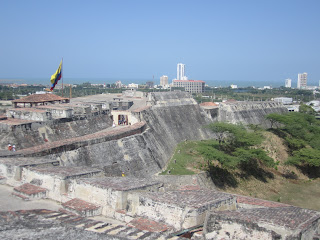On Monday evening (23 Jan) I flew from Bogota to Cartagena, one of the largest cities on Colombia’s Northern coast. Cartagena is frequently cited in guidebooks as one of the best preserved examples of a Spanish colonial town - it was a vital seaport for the Spanish in South America, and a point of departure for the vast amounts of wealth going to Europe. In recent years it has seen a tremendous boom in its tourism industry, which is only expected to continue as Colombia’s political situation improves.
The first thing that struck me on stepping off the plane was the heat - even arriving at 9pm it was like walking into an oven, not helped by the ever-present humidity. Even at night the temperature rarely drops below 25°C, and anywhere between 30 and 40 during the day (it’s mid-summer here at the moment). This was a huge contrast to Bogota, where it had been cold enough to need a jumper!
Views from San Felipe
City walls (“Murallas”)
The first day in Cartagena was spent wandering the city walls and the San Felipe fort which dominates the Southern side of the old town. The fort is extremely impressive, with interlocking series of battlements and batteries making it, in the words of one British attacker, “formibidable”. The Spanish treasure fleets departing from Cartagena made a tempting target, and the city came under attack several times, notably by the British in both the sixteenth and eighteenth century (Francis Drake had a good crack at it). For this reason the city and the surrounding area were steadily reinforced with increasingly sophisticated defences over several centuries.
If you’re not a military history geek, then the real draw for Cartagena is the ridiculously pretty architecture of the old town, which is a maze of narrow streets, overlooked by balconies covered in ivy and hidden plazas around every corner.
The second day in Cartagena was given over to a thorough exploration of the old town, where, to my delight, I was even able to find a naval history museum (Cartagena is an important base for the Colombian navy). Highlights of the old town included a number of churches whose spires and domes peak out above their surrounding buildings, and numerous street-corner cafes and bars. I was able to occupy myself there for several hours, before heading out in the evening for a few beers with an uncle who happened to be visiting Cartagena on business. The old town is the centre of activity for visitors, with a large number of hotels and hostels within the historic buildings catering for anyone from the budget traveller to 5* luxury.
Day 3 was spent relaxing on one of the beaches on Boca Grande (a projection of land which forms a large natural harbour) overlooked by modern high-rise blocks of flats which dominate the Cartagena skyline, which have grown up in response to Cartagena’s increasing desirability to both foreign tourists and wealthy Colombians. While not quite the idyllic white sands of the Caribbean postcard, and in some places rather crowded, very few parts of Cartagena are more than a 5-10 minute walk from the beach.
View of Boca Grande (Sorry for the ship-porn. The USS Elrod if anyone’s interested)
From Cartagena it is also possible to take a day trip to the nearby Rosario Islands, an archipelago of 29 small Caribbean islands which form a protected National Park. According to a local source, the most desirable island is not currently open to the public as the drug lord who used to lease it and run it as a tourist destination was arrested and his assets seized. The islands can be reached by a 45-60 minute powerboat ride from the centre of Cartagena to whichever island one is visiting. Should you ever find yourself in that part of the world, be warned, they are a definite tourist trap if you are after anything more than lounging on a beach. The islands predominantly cater to day-trippers from Cartagena, and the guys running the tours will try and squeeze every extra peso out of tourists for additional activities such as snorkeling or scuba diving - a far better alternative would be to go further along the coast to Tayrona, or out to the islands of San Andres and Providencia where these are much cheaper and there is more to see.
It’s a hard life...
Next time: Week 2 “La Cuidad Perdida” and Tayrona National Park







No comments:
Post a Comment